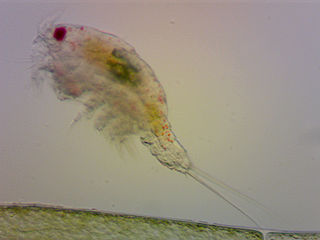
Diaptomus is a genus of copepods with a single eye spot. It is superficially similar in size and appearance to Cyclops. However it has characteristically very long first antennae that exceed the body length. In addition, the females carry the eggs in a single sac rather than the twin sacs seen in Cyclops. It is a copepod of larger freshwater ponds, lakes and still waters.
Aglaodiaptomus is a genus of copepods in the family Diaptomidae. They are often bright red or blue due to carotenoid pigments.

Attheyella is a genus of copepods in the family Canthocamptidae, containing the following species:
Boeckella bispinosa is a species of calanoid copepod in the family Centropagidae.
Boeckella calcaris is a species of calanoid copepod in the family Centropagidae.
Boeckella geniculata is a species of calanoid copepod in the family Centropagidae.
Boeckella shieli is a species of calanoid copepod in the family Centropagidae.

Branchinecta is a genus of crustacean in family Branchinectidae. It includes around 50 species, found on all continents except Australia. Branchinecta gigas, the giant fairy shrimp, is the largest species in the order, with a length of up to 10 centimetres (4 in), and Branchinecta brushi lives at the highest altitude of any crustacean, at 5,930 metres (19,460 ft), a record it shares with the copepod Boeckella palustris. A new genus, Archaebranchinecta was established in 2011 for two species previously placed in Branchinecta.
Calamoecia is a genus of copepods in the family Centropagidae confined to Australasia. It is thought to have evolved since the separation of the Australian continent from Antarctica. Three of the Australian endemic species are listed as vulnerable species on the IUCN Red List. The genus contains the following species:
Elaphoidella is a genus of freshwater copepods in the family Canthocamptidae. It contains over 200 species, including three classified as vulnerable species by the IUCN – three endemic to Slovenia and one endemic to the United States. In total, the genus Elaphoidella contains the following species:
Fibulacamptus is an Australian endemic genus of crustacean in the family Canthocamptidae. Two of the four species are listed as vulnerable species on the IUCN Red List :
Hesperodiaptomus is a genus of copepods in the family Diaptomidae, containing 18 species. Two species – Hesperodiaptomus augustaensis and Hesperodiaptomus californiensis – are endemic to the United States and listed as vulnerable species on the IUCN Red List.
Mastigodiaptomus is a genus of Neotropical copepods in the family Diaptomidae. Two of the eight species in the genus are listed as Data Deficient (DD) on the IUCN Red List, and one is listed as a vulnerable species (VU):
Neodiaptomus is a genus of freshwater copepods in the family Diaptomidae. It contains the following species, four of which are listed as vulnerable species on the IUCN Red List :
Neutrodiaptomus is a genus of copepods in the family Diaptomidae. The Japanese endemic species N. formosus is listed as Data Deficient on the IUCN Red List. The genus Neutrodiaptomus contains the following species:
Notodiaptomus is a genus of copepods in the family Diaptomidae. It is the most widely distributed, most abundant and most species-rich genus of freshwater calanoid copepods in the Neotropics. The genus was erected in 1936 by Friedrich Kiefer for eleven species formerly placed in a wider Diaptomus. Notodiaptomus deitersi was chosen to be the type species by Raúl Adolfo Ringuelet in 1958.
Paradiaptomus is a genus of crustacean in the family Diaptomidae. It includes the following species:
Skistodiaptomus is a genus of freshwater copepods in the family Diaptomidae, found across North America. The genus contains eight species, three of which are endemic to the United States and are listed on the IUCN Red List as vulnerable species (VU) or Data Deficient (DD).
Thermodiaptomus is a genus of copepods in the family Diaptomidae, containing the following species:
Tropodiaptomus is a genus of copepods in the family Diaptomidae. It includes the following species, many of which are narrow endemics and are included on the IUCN Red List :


